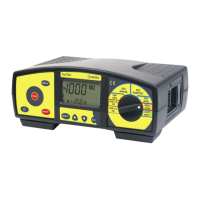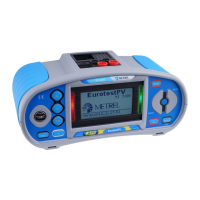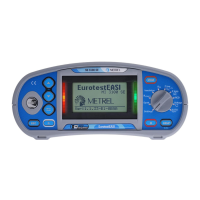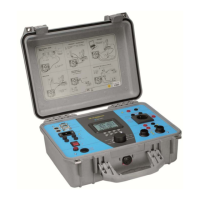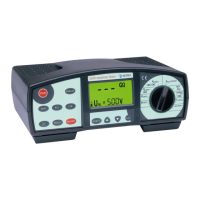MI 3000 EasiPLUS Safety and operational considerations
9
Testing the PE terminal
The PE terminal can only be tested in the RCD, LOOP and LINE functions!
For correct testing of PE terminal, the TEST key has to be touched for a few
seconds.
Make sure to stand on non-isolated floor while carrying out the test, otherwise the
test result may be wrong!
2.2 Batteries
When connected to an installation, the instruments battery compartment can
contain hazardous voltage inside! When replacing battery cells or before
opening the battery/fuse compartment cover, disconnect any measuring
accessory connected to the instrument and turn off the instrument,
Ensure that the battery cells are inserted correctly otherwise the instrument will
not operate and the batteries could be discharged.
If the instrument is not to be used for a long period of time, remove all batteries
from the battery compartment.
Alkaline or rechargeable Ni-Cd or Ni-MH batteries (size AA) can be used. Metrel
recommends only using rechargeable batteries with a capacity of 2100mAh or
above.
Do not recharge alkaline battery cells!
2.3 Charging
The batteries will begin charging whenever the power supply adapter is connected to
the instrument. The built-in protection circuits control the charging procedure and assure
maximum battery lifetime. The power supply socket polarity is shown in figure 2.1.
+
-
Figure 2.1: Power supply socket polarity
Note:
Use only power supply adapter delivered from the manufacturer or distributor of
the test equipment to avoid possible fire or electric shock!
2.4 Precautions on charging of new battery cells or cells
unused for a longer period
Unpredictable chemical processes can occur during the charging of new battery cells or
cells that have been left unused for long periods of time (more than 3 months). Ni-MH
and Ni-Cd cells can be subject to these chemical effects (sometimes called the memory
effect). As a result the instrument operation time can be significantly reduced during the
initial charging/discharging cycles of the batteries.

